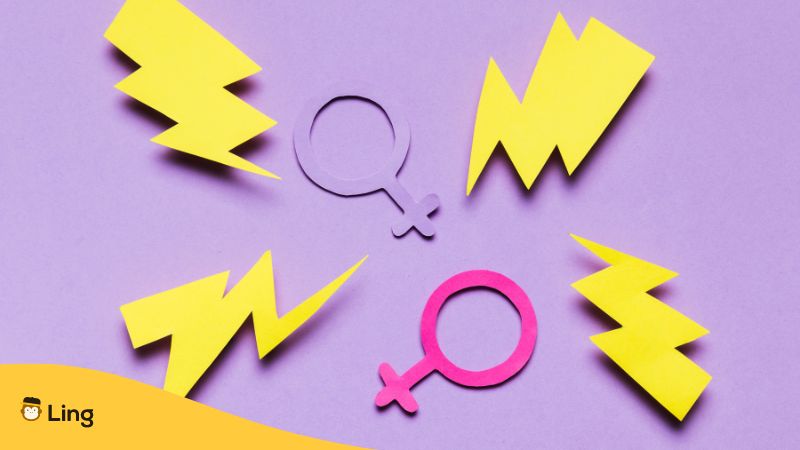If you’re learning German, you’ve probably encountered the challenge of making German words plural. Unlike English, where you simply add the suffix -s or -es, German has a complex system for forming plurals, which can be seriously tough for beginners. However, once you understand the rules, you’ll be able to make nouns plural with ease. In this guide, we’ll explore the various ways to pluralize and provide you with some useful examples to understand this grammatical point better. Let’s begin!
It’s important to learn how to form plurals in German because it’s an essential part of the language and is necessary for effective communication. Imagine if you’re buying some food, e.g., some apples, and you can’t say die Äpfel to the vendor. Wouldn’t that feel a teeny bit embarrassing? Add to that the fact that if you use the wrong plural endings, your speech may end up sounding too unnatural or confusing to native speakers. Now that’s something I bet none of us don’t want to experience!
Although grammar is indeed a challenging aspect to learn, mastering the basics, including how to use German nouns, is incredibly important. In our opinion, it’s the foundation for learning the language, so if you don’t truly understand those singular and plural nouns, then you’ll have trouble understanding the more complex intricacies of this language. But don’t worry because we’ve got your back in this post! Today, we’ll go over everything you need to know to nail this grammar point!

Understanding German Noun Genders
Before we dive into plural forms, it’s important to understand that German nouns have genders. Basically, there are three genders in German that you need to take note of: masculine, feminine, and neuter. Each gender has its own set of articles and pronouns, and it affects the formation of plurals.
Masculine Nouns – der (the)
Masculine nouns in German are often characterized by the suffixes -er, -el, -ling, and -ich. However, not all masculine nouns have these endings. Aside from those endings, remember that car brands, names of seasons, days of the week, months, and compass directions are mostly in the masculine form. Some examples of masculine nouns are “der Mann” (man), “der Hund” (dog), and “der Schüler” (student).
Feminine Nouns – die (the)
Feminine nouns in German are often characterized by the suffixes -in, -heit, -keit, and -schaft. However, do note that now all feminine nouns have these endings. Aside from the suffixes we mentioned, the numbers and the names of planes, ships, trees, and foreign loan words are mostly feminine nouns. Some examples of feminine nouns are “die Frau” (woman), “die Katze” (cat), and “die Lehrerin” (teacher).
Neuter Nouns – das (the)
Neuter nouns in German are often characterized by the suffixes -chen, -lein, -um, and -tum. However, not all neuter nouns may have these endings. Dimunitivies, colors, and nouns that come from verbs and adjectives are usually considered neuter nouns. Some examples of neuter nouns are “das Kind” (child), “das Haus” (house), and “das Auto” (car).

Making German Words Plural
Ready to start forming your German plural nouns? In this section, we’ll focus on the exact rules you need to follow so that you can finally make German words in the plural form.
Adding “-e” To Nouns
One of the most common ways to make German nouns plural is to add the suffix “-e” to the end of the noun. This applies to nouns that end in a vowel, as well as some masculine and neuter nouns. For masculine, one tip is to look for nouns with the endings -eur, -ich, -ier, -ig, -ling, and -ör. For feminine/neuter nouns, look for words ending with -nis or -sal.
For example:
- “der Hund” (dogs) becomes “die Hunde” (dogs)
- “der Arm” (arm) becomes “die Arme” (arms)
- “der Stuhl” (chair) becomes “die Stühle” (chairs)
- “der Koch” (chef) becomes “die Köche” (chefs)
See the sudden addition of umlaut in the last example? This is the case for most masculine nouns which follow this pattern.
Adding “-er” To Nouns
The following pattern is commonly observed among neuter nouns, although it can also be found in masculine nouns, albeit very rarely. If a neuter noun ends in -tum, it will always follow this pattern for its plural form.
For example:
- “der Gott” (god) becomes “die Götter” (gods)
- “der Mann” (man) becomes “die Männer” (men)
- “der Mund” (mouth) becomes “die Münder” (mouths)
- “das Wurm” becomes “die Würmer” (worms)
Wait! Is that another Umlaut? Yes! We need to add Umlaut all the time when we are adding”-er” endings to nouns.
Adding “-n/-en” To Nouns
Another way to make German nouns plural is to add the suffix “-n” or “-en” to the end of the noun to some masculine and neuter nouns. If a masculine and neuter noun ends in -e, we need to add an -en ending to craft the plural. For feminine nouns that end with -el or -er, we need to add an -n.
- “das Auge” (eye) becomes “die Augen” (eyes)
- “die Schlange” (snake) becomes “die Schlangen” (snakes)
- “der Student” (student) becomes “die Studenten” (students)
- “die Frau” (woman) became “die Frauen” (women)
Unlike the previous rules, we do not need to add an Umlaut to these nouns.
Adding “-s” To Nouns
Adding “-s” to the end of a noun is also a way to make it plural in German. However, this is not very common and is only used for loanwords from English or other languages.
- “das Auto” (car) becomes “die Autos” (cars)
- “das Radio” (radio) becomes “die Radios” (radios)
No Change Nouns
Similar to English, German also has some nouns which do not change when creating a plural. Usually, neuter nouns ending with -chen and -lein and masculine nouns with the endings -el, -en, and -er should follow this rule.
- “der Löffel” (spoon) becomes “die Löffel” (spoons)
- “das Mädchen” (girl) becomes “die Mädchen” (girls)
- “der Onkel” (uncle) becomes “die Onkel” (uncles)
It’s important to note that there are some irregular plural forms in German that do not follow these rules. Additionally, some nouns may have more than one plural form, depending on their meaning. However, these general rules should help you form plurals for most German nouns based on their gender.
Nouns With Different Plural Meanings
In German, some nouns have different plural forms depending on their meaning. This can make learning the language a bit tricky, as the same word can have different endings and pronunciations depending on its context. Here are some examples of German nouns that have different plural forms for different meanings:
- “der Band” (the volume, the ribbon) – When “Band” refers to a volume or book, its plural form is “die Bände.” However, when it refers to “das Band” as in ribbon, its plural form is “die Bänder.”
- “die Bank” (the bench, the bank) – When “Bank” refers to a bench, its plural form is “die Bänke.” However, when it refers to a financial institution, its plural form is “die Banken.”
- “der Schuh” (the shoe) – When “Schuh” refers to a single shoe, its plural form is “die Schuhe.” However, when it refers to a specific part of the foot, its plural form is “die Schuh” or “die Schuhe.”
These examples demonstrate how the same noun can have different plural forms depending on its meaning, which can be confusing for learners of German. It’s important to pay close attention to context when encountering such words in order to use the correct plural form.
Exception To Plural Rules In German
Not all words in German have plural forms. Some words, such as uncountable nouns and collective nouns, are used only in the singular form. Here are some examples:
- “das Wasser” (water) – Water is an uncountable noun in German and does not have a plural form.
- die Zweisprachigkeit (bilingualism) – Concepts are also considered to have no plural forms in the German language.
- “der Käse” (cheese) – Cheese is another uncountable noun in German and does not have a plural form.
- “die Musik” (music) – Like water and cheese, music is an uncountable noun in German and is only used in the singular form.
- “der Verkehr” (traffic) – Verkehr is another collective noun in German and is used only in the singular form.
- “die Heimat” (home) – Heimat is a noun that only exists in singular form, as in German understanding, you can only have one home.
It’s important to note that some of these uncountable nouns may have related nouns that can be pluralized. For example, “der Käse” (cheese) can be pluralized as “die Käsesorten” (types of cheese), and “die Familie” (family) can be pluralized as “die Familien” (families) when referring to multiple families. However, the original uncountable noun still remains in the singular form.
What Are Umlauts?
Umlauts are a unique feature of the German language that involves modifying the vowels ä, ö, and ü by adding two dots above them. These dots on top of the letters change the sound of the vowel and are used to differentiate between certain words. Umlauts can appear in both singular and plural forms of German nouns and are often used when forming adjectives or other related words.
| English | English Plural | German | German Plural | Sound |
|---|---|---|---|---|
| door | doors | die Tür | die Türen | |
| foot | feet | der Fuß | die Füße | |
| house | houses | das Haus | die Häuser | |
| man | men | der Mann | die Männer | |
| daughter | daughters | die Tochter | die Töchter |
Common Plural Words In German

Learn German Now With Ling
Looking for an effective and engaging way to learn German? Look no further than Ling! Ling is the best language-learning app for anyone looking to master German quickly and easily.
With Ling, you’ll have access to a wide range of interactive lessons and exercises designed to help you build your vocabulary, improve your grammar, and develop your conversational skills. You’ll learn from lessons made by native German speakers that’ll guide you through each linguistic point.
Ling’s unique features include a personalized learning experience that adapts to your skill level and learning style, as well as a speech recognition tool that lets you practice your pronunciation and accent. You can also track your progress and earn bananas as you complete lessons, keeping you motivated and engaged.
Ready to give it a try? Download Ling from the App Store or Play Store today!



































































